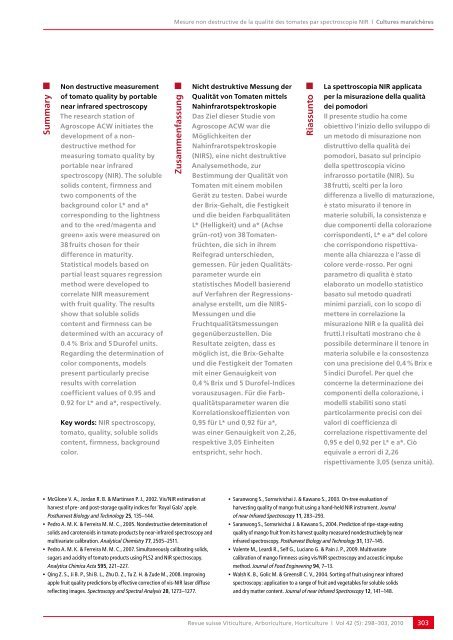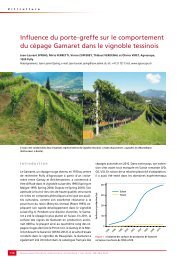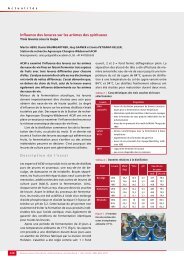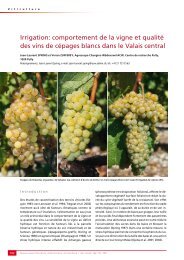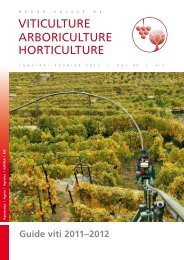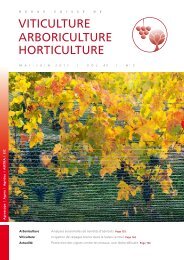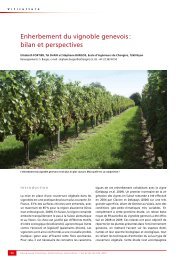Télécharger le PDF - Revue suisse de viticulture arboriculture ...
Télécharger le PDF - Revue suisse de viticulture arboriculture ...
Télécharger le PDF - Revue suisse de viticulture arboriculture ...
You also want an ePaper? Increase the reach of your titles
YUMPU automatically turns print PDFs into web optimized ePapers that Google loves.
Summary<br />
Non <strong>de</strong>structive measurement<br />
of tomato quality by portab<strong>le</strong><br />
near infrared spectroscopy<br />
The research station of<br />
Agroscope ACW initiates the<br />
<strong>de</strong>velopment of a non<strong>de</strong>structive<br />
method for<br />
measuring tomato quality by<br />
portab<strong>le</strong> near infrared<br />
spectroscopy (NIR). The solub<strong>le</strong><br />
solids content, firmness and<br />
two components of the<br />
background color L* and a*<br />
corresponding to the lightness<br />
and to the «red/magenta and<br />
green» axis were measured on<br />
38 fruits chosen for their<br />
difference in maturity.<br />
Statistical mo<strong>de</strong>ls based on<br />
partial <strong>le</strong>ast squares regression<br />
method were <strong>de</strong>veloped to<br />
correlate NIR measurement<br />
with fruit quality. The results<br />
show that solub<strong>le</strong> solids<br />
content and firmness can be<br />
<strong>de</strong>termined with an accuracy of<br />
0.4 % Brix and 5 Durofel units.<br />
Regarding the <strong>de</strong>termination of<br />
color components, mo<strong>de</strong>ls<br />
present particularly precise<br />
results with correlation<br />
coefficient values of 0.95 and<br />
0.92 for L* and a*, respectively.<br />
Key words: NIR spectroscopy,<br />
tomato, quality, solub<strong>le</strong> solids<br />
content, firmness, background<br />
color.<br />
Mesure non <strong>de</strong>structive <strong>de</strong> la qualité <strong>de</strong>s tomates par spectroscopie NIR | Cultures maraîchères<br />
Zusammenfassung<br />
b McGlone V. A., Jordan R. B. & Martinsen P. J., 2002. Vis/NIR estimation at<br />
harvest of pre- and post-storage quality indices for ‘Royal Gala’ app<strong>le</strong>.<br />
Postharvest Biology and Technology 25, 135–144.<br />
b Pedro A. M. K. & Ferreira M. M. C., 2005. Non<strong>de</strong>structive <strong>de</strong>termination of<br />
solids and carotenoids in tomato products by near-infrared spectroscopy and<br />
multivariate calibration. Analytical Chemistry 77, 2505–2511.<br />
b Pedro A. M. K. & Ferreira M. M. C., 2007. Simultaneously calibrating solids,<br />
sugars and acidity of tomato products using PLS2 and NIR spectroscopy.<br />
Analytica Chimica Acta 595, 221–227.<br />
b Qing Z. S., Ji B. P., Shi B. L., Zhu D. Z., Tu Z. H. & Zu<strong>de</strong> M., 2008. Improving<br />
app<strong>le</strong> fruit quality predictions by effective correction of vis-NIR laser diffuse<br />
ref<strong>le</strong>cting images. Spectroscopy and Spectral Analysis 28, 1273–1277.<br />
Nicht <strong>de</strong>struktive Messung <strong>de</strong>r<br />
Qualität von Tomaten mittels<br />
Nahinfrarotspektroskopie<br />
Das Ziel dieser Studie von<br />
Agroscope ACW war die<br />
Möglichkeiten <strong>de</strong>r<br />
Nahinfrarotspektroskopie<br />
(NIRS), eine nicht <strong>de</strong>struktive<br />
Analysemetho<strong>de</strong>, zur<br />
Bestimmung <strong>de</strong>r Qualität von<br />
Tomaten mit einem mobi<strong>le</strong>n<br />
Gerät zu testen. Dabei wur<strong>de</strong><br />
<strong>de</strong>r Brix-Gehalt, die Festigkeit<br />
und die bei<strong>de</strong>n Farbqualitäten<br />
L* (Helligkeit) und a* (Achse<br />
grün-rot) von 38 Tomatenfrüchten,<br />
die sich in ihrem<br />
Reifegrad unterschie<strong>de</strong>n,<br />
gemessen. Für je<strong>de</strong>n Qualitätsparameter<br />
wur<strong>de</strong> ein<br />
statistisches Mo<strong>de</strong>ll basierend<br />
auf Verfahren <strong>de</strong>r Regressionsanalyse<br />
erstellt, um die NIRS-<br />
Messungen und die<br />
Fruchtqualitätsmessungen<br />
gegenüberzustel<strong>le</strong>n. Die<br />
Resultate zeigten, dass es<br />
möglich ist, die Brix-Gehalte<br />
und die Festigkeit <strong>de</strong>r Tomaten<br />
mit einer Genauigkeit von<br />
0,4 % Brix und 5 Durofel-Indices<br />
vorauszusagen. Für die Farbqualitätsparameter<br />
waren die<br />
Korrelationskoeffizienten von<br />
0,95 für L* und 0,92 für a*,<br />
was einer Genauigkeit von 2,26,<br />
respektive 3,05 Einheiten<br />
entspricht, sehr hoch.<br />
Riassunto<br />
La spettroscopia NIR applicata<br />
per la misurazione <strong>de</strong>lla qualità<br />
<strong>de</strong>i pomodori<br />
Il presente studio ha come<br />
obiettivo l’inizio <strong>de</strong>llo sviluppo di<br />
un metodo di misurazione non<br />
distruttivo <strong>de</strong>lla qualità <strong>de</strong>i<br />
pomodori, basato sul principio<br />
<strong>de</strong>lla spettroscopia vicino<br />
infrarosso portati<strong>le</strong> (NIR). Su<br />
38 frutti, scelti per la loro<br />
differenza a livello di maturazione,<br />
è stato misurato il tenore in<br />
materie solubili, la consistenza e<br />
due componenti <strong>de</strong>lla colorazione<br />
corrispon<strong>de</strong>nti, L* e a* <strong>de</strong>l colore<br />
che corrispondono rispettivamente<br />
alla chiarezza e l’asse di<br />
colore ver<strong>de</strong>-rosso. Per ogni<br />
parametro di qualità è stato<br />
elaborato un mo<strong>de</strong>llo statistico<br />
basato sul metodo quadrati<br />
minimi parziali, con lo scopo di<br />
mettere in correlazione la<br />
misurazione NIR e la qualità <strong>de</strong>i<br />
frutti.I risultati mostrano che è<br />
possibi<strong>le</strong> <strong>de</strong>terminare il tenore in<br />
materia solubi<strong>le</strong> e la consostenza<br />
con una precisione <strong>de</strong>l 0,4 % Brix e<br />
5 indici Durofel. Per quel che<br />
concerne la <strong>de</strong>terminazione <strong>de</strong>i<br />
componenti <strong>de</strong>lla colorazione, i<br />
mo<strong>de</strong>lli stabiliti sono stati<br />
particolarmente precisi con <strong>de</strong>i<br />
valori di coefficienza di<br />
correlazione rispettivamente <strong>de</strong>l<br />
0,95 e <strong>de</strong>l 0,92 per L* e a*. Ciò<br />
equiva<strong>le</strong> a errori di 2,26<br />
rispettivamente 3,05 (senza unità).<br />
b Saranwong S., Sornsrivichai J. & Kawano S., 2003. On-tree evaluation of<br />
harvesting quality of mango fruit using a hand-held NIR instrument. Journal<br />
of near Infrared Spectroscopy 11, 283–293.<br />
b Saranwong S., Sornsrivichai J. & Kawano S., 2004. Prediction of ripe-stage eating<br />
quality of mango fruit from its harvest quality measured non<strong>de</strong>structively by near<br />
infrared spectroscopy. Postharvest Biology and Technology 31, 137–145.<br />
b Va<strong>le</strong>nte M., Leardi R., Self G., Luciano G. & Pain J. P., 2009. Multivariate<br />
calibration of mango firmness using vis/NIR spectroscopy and acoustic impulse<br />
method. Journal of Food Engineering 94, 7–13.<br />
b Walsh K. B., Golic M. & Greensill C. V., 2004. Sorting of fruit using near infrared<br />
spectroscopy: application to a range of fruit and vegetab<strong>le</strong>s for solub<strong>le</strong> solids<br />
and dry matter content. Journal of near Infrared Spectroscopy 12, 141–148.<br />
<strong>Revue</strong> <strong>suisse</strong> Viticulture, Arboriculture, Horticulture | Vol 42 (5) : 298–303, 2010 303


